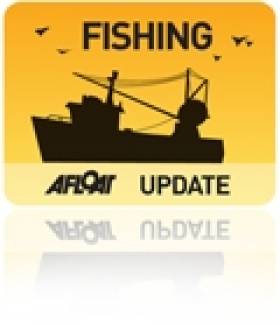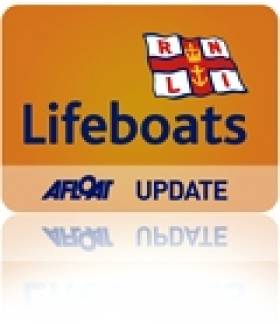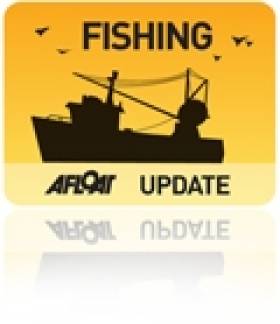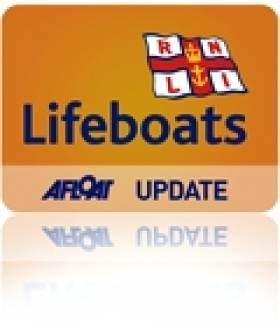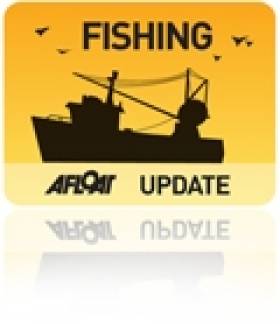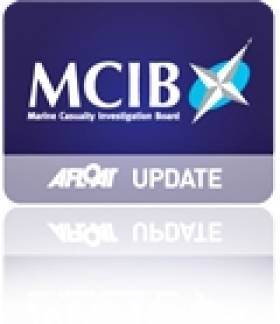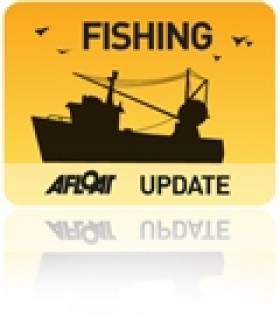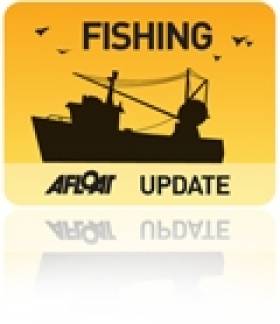Displaying items by tag: Fishing
Spanish Fisherman Airlifted To Hospital in Coastguard Medivac
#Coastguard - Galway Bay FM reports that a man was airlifted by the coastguard from a Spanish fishing trawler off the Galway coast last night (5 August).
The Irish Coast Guard's Shannon-based Rescue 115 helicopter was dispatched to the trawler Brierio some 80 nautical miles west of the Irish coast to retrieve the fisherman, who The Irish Times says was experiencing breathing difficulties.
He was taken to Mid-Western Regional Hospital in Limerick for medical attention.
Fishing Vessel Sought Immediate Naval Assistance
#TrawlerRescue- An Irish registered fishing trawler the Saint Claire sought immediate assistance from the Naval Service when approximately 80 miles west of Dingle Peninsula on Thursday evening.
The OPV L.É. Niamh (P52) responded to the request as the trawler had engineering problems and was unable to generate power. Within an hour of the call the OPV had arrived on the scene.
A team boarded the Saint Claire to assess the situation which led the vessel to be taken under tow to Castletownbere, West Cork. According to the Naval Service all crew are safe and uninjured.
Kilmore Quay & Wicklow RNLI In Separate East Coast Assists
#RNLI - Kilmore Quay RNLI has assisted a fisherman after his boat got into difficulty off the Wexford coast, while Wicklow RNLI attended to a fishing boat in trouble south of Wicklow Harbour.
The Kilmore Quay all-weather lifeboat was requested to launch at 9.04am on Monday morning (29 July) to go to the assistance of a local lobster boat with one person on board,
The fishing boat had fouled its propeller while hauling pots a mile to the south-east of the Little Saltee Island.
Weather conditions at the time were blowing a light southerly breeze and there was good visibility.
When the lifeboat arrived on scene, a tow was set up and the vessel was brought safely to the harbour at Kilmore Quay.
Shortly afterwards, Wicklow RNLI launched at 9.30am in response to a call for assistance from a fishing vessel in difficulties six miles south of Wicklow Harbour.
The vessel with three crew was fishing north of Brittas Bay beach when a rope got fouled in the propeller and she lost steering. The skipper contacted the coastguard for assistance.
Wicklow town's lifeboat, under the command of coxswain Nick Keogh, located the vessel drifting close to the Wolf Rock 20 minutes after launching.
A towline was quickly established and the stricken vessel was towed back to Wicklow Harbour, where she was secured safely alongside the East Pier at 10.40am.
The crew on the call out were coxswain Nick Keogh, mechanic Brendan Copeland, Tommy McAulay, Kevin Rahill, Carol Flahive, Paul Sillery and Graham Fitzgerald.
#Fishing - "Absolutely hammered" is how a Carlingford Lough oyster farmer describes the state of his business after £350,000 (€404,000) worth of his stock was destroyed by a virus in the recent heatwave.
And as the Belfast Telegraph reports, Darren Cunningham now fears financial ruin after at least 80% of his juvenile oysters were wiped out by the ostreid herpes virus, which kills the shellfish when the water temperature rises above 16 degrees.
Unfortunately for Cunningham and fellow oysterman Harold Henning, who fears a total loss of his young oysters, Stormont has no compensation scheme in place for lost stocks in Northern Ireland.
The Belfast Telegraph has more on the story HERE.
#RNLI - The volunteer lifeboat crew of the Courtown lifeboat launched last Wednesday evening (24 July) to a report of a small fishing boat that was overdue on its time to return to Cahore Pier.
The Courtown RNLI lifeboat, Cahore Inshore Rescue, the Rosslare RNLI lifeboat and the Irish Coast Guard helicopter Rescue 117 were all tasked at 7pm to search the area of Cahore on the north Wexford coast, where the boat was last reported fishing.
After searching for some time, the small fishing boat made contact to say they had beached their boat some eight miles north of Cahore Pier at Kilgorman Beach. Both men were safe and well and all rescue services were stood down.
The Courtown lifeboat has since urged all boat users carry a proper means of communication - ideally a VHF radio - and to keep friends and family up to date on their location, especially if they decide to change their location.
That same evening, Rosslare Harbour RNLI was involved in a search for two fishermen after they reported getting into difficulty off the Wexford coast.
The volunteer crew launched their all-weather lifeboat at 7.30pm to assist in the search following a request from the coastguard to attend a fishing boat that was reported to be taking on water.
Weather conditions at the time were described as good, with a southerly force three wind.
The fishing boat had set out from Cahore Harbour before getting into trouble. The two crew raised the alarm using a mobile telephone.
Rosslare Harbour RNLI and lifeboats from Courtown RNLI and Cahore, along with the Rescue 117 helicopter, joined in the search.
At 7.50pm, Rescue 117 located the two fishermen safe and well and their vessel on the beach at Glasgorman, near Cahore.
Speaking after the call-out, Rosslare Harbour RNLI deputy volunteer lifeboat press officer Jamie Ryan said: "The emergency services responded swiftly and were on scene quickly.
"The two fishermen did the right thing by raising the alarm when they got into difficulty and thankfully they were both found safely ashore."
Giant Monkfish Among West Coast Fishermen's Strange Catches
#Fishing - Irish fishermen have reported some unusual catches in recent days, according to The Irish Times.
Galway trawler Martins Marie brought home a massive lobster weighting almost 3kg with a carapace of more than 15cm.
But Rossaveal vessel Virtuous did one better on their trip to the Porcupine Bank by landing a giant monkfish that weighed in at 40kg even after gutting.
The Irish Times has more on this story HERE.
Coveney Secures Agreement to Prepare for Trade Restrictions Against Iceland and Faroes
#mackerel – Minister Simon Coveney T.D., supported by the UK, France and Spain today at the Council of Ministers today pushed strongly to have trade restrictions imposed immediately by the EU Commission against Iceland and the Faroe Islands as a result of their continued unacceptable and irresponsible fishing of mackerel. Both Iceland and the Faroese have set large unilateral quotas at unsustainable levels in 2013. Their unilateral quotas amount to 52% of the recommended scientifically advised catch of mackerel in 2013.
This is the fifth year in which Iceland has refused to engage in meaningful negotiations with the EU and Norway, the recognised major shareholders in this fishery. Both Iceland and the Faroes have developed a large and unsustainable fishery of mackerel from a situation in 2006 when they had a combined total share of only 5% of the fishery.
Minister Coveney said "I called for and secured the agreement of Commissioner Damanaki that the EU will immediately prepare for trade restrictions against Iceland and the Faroe Islands. I received strong support from many Member States including the UK, France, Spain, Portugal, the Netherlands. Both Iceland and the Faroes have repeatedly refused to engage in any meaningful negotiations with the EU and Norway over the past 5 years. This is simply unacceptable as they are now fishing over 50% of the scientifically recommended catch level for mackerel. I am pleased that the Commissioner and most Member States supported moving quickly during this fishing season to take strong and decisive measures.
We have been left with no choice and must act against these countries being rewarded by their unsustainable and irresponsible behaviour. I regret that we have been forced to take this action but the continued absence of any meaningful attempt to negotiate by either country has left us with no alternative."
The North East Atlantic mackerel fishery, if fished within recommended levels, is worth about €1 billion with a value to the European Union , as the largest shareholder, estimated to be over €600 million.
Minister Coveney added "mackerel is our most important fishery worth over €125m to us and Irish fishermen are hugely dependant on it and cannot accept their livelihoods being threatened in this way.
If this irresponsible fishing is allowed to continue this stock will be decimated and our fishermen and coastal communities will have their livelihoods completely undermined. There are many fish processing factories in Donegal and also factories in Galway, Kerry and Cork dependent on this stock. I am compelled to do all I can to protect this Irish industry and all the jobs it provides.
I have been calling consistently for the implementation of trade measures for more than 12 months and today the Commissioner has agreed to proceed to implement these measures."
Fisherman Drowned 100 Metres From Shallows Says MCIB Report
#MCIB - Various factors - including poor buoyancy, suboptimal lifejackets and a fateful late decision to swim to shore - have been identified in the official report into the death of a fisherman off the Waterford coast earlier this year.
As previously reported on Afloat.ie, a major search and rescue operation was launched on 10 January when a 16-foot fishing punt capsized in a strong swell at the sandbar off Brownstown Head near Dunmore East, throwing its two-man crew overboard.
James Tate was able to swim to the nearby shore in the early morning darkness after some two hours in the water. But he became separated from his friend Johnny Flynn - a former member of the Dunmore East lifeboat crew - who was found unconscious in the water by coastguard helicopter before 8.30am.
Flynn was pronounced dead at Waterford Airport shortly after, with a post-mortem concluding that he cause of death was drowning.
The tragedy occurred six years to the day after the sinking of Dunmore East trawler the Pere Charles, which took five lives.
In the official report into the incident, the Marine Casualty Investigation Board (MCIB) found that the fishing punt, already vulnerable to breaking waves as an un-decked open boat, was more susceptible due to its waterlogged condition, and the lack of adequate buoyancy.
It was also found that neither the vessel's handheld VHF radio nor GPS device, or indeed Tate's mobile phone, were available to the pair after the boat turned turtle.
Though both men were wearing lifejackets, they were of a kind that lacked a collar that would have kept the deceased's head above water, nor did they have a light or whistle. Only Tate was equipped with any kind of light, so he could not locate his friend in the dark.
Most importantly, it was found that the boat had overturned within 100 metres of the shallows, so that if the pair had attempted to swim to shore earlier - rather than tire themselves out trying to climb onto the upturned hull - the chances of both men surviving the incident "would have been greatly enhanced".
The full report into the incident is available to download below.
Coveney Blasts Iceland's 'Irresponsible' Mackerel Quota
#Fishing - Mackerel quotas will be the focus of discussions among European fisheries ministers in Brussels today as Ireland seeks a reduction of Iceland's share.
As RTÉ News reports, Marine Minister Simon Coveney will seek "strong and decisive action" against Iceland and the Faroe Islands unless the European Commission reports progress in talks over the realignment of mackerel catch limits.
Iceland's quota for mackerel increased from 2,000 tonnes in 2009 to a whopping 146,000 tonnes just two years later as stocks of the staple fish soared - partly due to migration from more southerly European waters.
But Minister Coveney has blasted Iceland's move as "irresponsible and unacceptable fishing".
The talks come in the wake of fruitful reform of the Common Fisheries Policy led by the minister as president of the EU Fisheries Council during Ireland's EU Presidency in the first half of this year.
CFP Reform Reaches Final Hurdle In Brussels
#CFP - RTÉ News reports that the "final battle" before reform of the Common Fisheries Policy (CFP) comes up today as a European Parliament committee votes on the changes led by the Irish Presidency of the EU in the first half of this year.
As previously reported on Afloat.ie, Europe's fisheries ministers agreed in May to a new policy that sets quotas based on scientific advice, with the aim of achieving healthy fish stocks and ultimately higher quotas as stocks are managed sustainably.
The reforms were pushed by Marine Minister Simon Coveney during his presidency of the EU Fisheries Council. The minister also made as his priority the ending of the practice of fish discards, a subject of much public outcry following revelations that as much as 50% of the catch in the North Sea is thrown back dead in the water.
Meanwhile, Ireland's additional quotas under the Hague Preferences have also been retained, a move that comes as some relief to the Irish fishing industry - which will also benefit from CFP amendments that would support the renewal of older fishing fleets.
However, conservation groups fear that these proposals would see the EU's fishing fleets grow to a size that far exceeds the available fisheries resource in European waters.



























